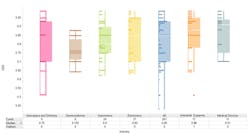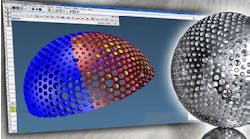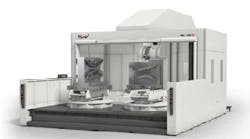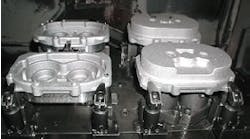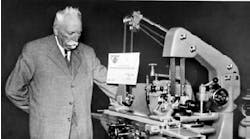Although machine-tool manufacturers were in overdrive to produce weapons and transportation during World War II, it was peacetime production where technology really began to flourish.
An Allied win in World War II might have never happened had it not been for the metalworking industry. Plants that had been turning out consumer goods had to rapidly re-tool for wartime production, and they needed machine tools that could cut, shape, and form metal faster, with greater precision and at lower cost. This need spurred phenomenal growth in the machine-tool business typified by the following handful of builders.
Fortunately, the industry didn't rest on its laurels once the war ended. Many machine-tool builders continued to emphasize technology as they expanded machinery product lines, looked to emerging offshore markets, or investigated entering new markets associated with metalworking.
Cincinnati Milacron: The Mill at war
When Japan forced the issue of war with the U.S. by bombing Pearl Harbor on December 7, 1941, it was a stark, stunning surprise, and the nation was ill-prepared. Less so the machine-tool industry. In the late 1930s, foreign military orders had been a major part of American tool makers' business. This overseas business turned out to be vital. After the fall of France, Britain quickly became the Cincinnati Milling Machine Co.'s (or the Mill) major customer. The $16.5 million worth of machines she bought from the Mill in 1940 helped sales soar from $13.7 million the previous year to $31.5 million.
Gearing up for war
For some time before the war, top management had been increasingly concerned about the state of U. S. defense preparations. They felt the government badly underestimated the defense industries' machine tool requirements in the event of war. Convinced, too, that if war came America could not avoid involvement, management decided in 1938 to expand the company's capacity despite the current recession. By the time the Japanese bombed Pearl Harbor, production space had doubled from 700,000 to 1.4 million square feet, and the Mill was ready to help fight a war.
As a measure of how important the Mill was to the war effort, consider that, in 1942, the company produced 17,511 machines and one of every 12 machines manufactured in the United States carried the company's name. To achieve this output required a massive network of 150 subcontractors all over the eastern third of the nation to make parts for Cincinnati machines—work the Mill would ordinarily have done for itself. And, while a new foundry worked around the clock, 27 outside foundries were also supplying castings to the Mill.
Engineering contributions
The Mill's engineers also contributed in key ways. In those pre-jet days, many warplanes had air-cooled gasoline engines, and it was difficult to make the fins of the aluminum cylinder heads thin enough to provide sufficient cooling. The Mill's engineers came up with a machine that would mill the fins thinner. It meant more warplanes with the crucial ability to fly faster and climb higher.
Early in the war, gunners in bomber crews discovered their guns sometimes shot up their own planes' wing and tail fins. The Mill devised an automatic profiler to make complex cams that locked out the firing mechanism unless the gun was aimed clear of the plane.
When the B-29 bomber was introduced late in the war, its engines had fuel-injection plungers ground and lapped to unheard-of tolerances of seven millionths (0.000007) of an inch, thanks to a special centerless grinder from the Mill. And, at war's end, the company was developing special machines to make the compressor fins for the first jet engines.
Supporting war production
The machine-tool buildup preceded weapons production and thus reached its peak relatively early in the war. The last big government order for the aviation industry, for instance, came in November 1942.
The next February, BUSINESS WEEK magazine reported the accomplishments of the machine-tool industry but foretold an un-certain future. The old specter of boom-and-bust had arisen again. By August 1945, when the Japanese surrendered, employment in the machine-tool industry had plunged sharply.
It might have fallen even more if the industry had built only machine tools. Late in the war, the Mill produced a wide variety of things: tractor parts, artillery-fuse setters, dies for ammunition makers, radar components, and landing-gear parts for B-29 bombers. At one point, a peacetime customer, Studebaker Corp., subcontracted the Mill to make transmissions for an amphibious landing craft called the Weasel.
Looking ahead
Despite the demands of war, the Mill went steadily ahead with its own research and development. Pioneering work was conducted on the physics of metalcutting, in particular, precisely what happens at the point where a cutting tool contacts a workpiece. The goal was to find better methods to increase tool life.
In 1938, the Mill's researchers confirmed that heat and pressure were the main causes of tool wear. They learned that it would take only slight reductions in heat to make tools last much longer. In one test, reducing heat from 950° to 900° extended tool life from 19.5 to 99 minutes. The question then became: how to reduce cutting temperatures? The Mill chose to concentrate on developing synthetic, water-based coolants that would be superior to traditional cutting oils. The Mill's first synthetic cutting fluid was marketed in May 1945. For the first time, the Mill was making and selling something other than machines.
Planning for peace
In February 1943, the Product Planning Committee identified four strategies to postwar growth:
To extend overseas manufacturing; to broaden machinery product lines; to enter the industrial consumables market; and to develop new technologies in the decades after the war. Their deliberations and decisions proved crucial to the Mill's continued prosperity through diversification.
While a number of more conservative machine-tool companies had to sell out or close up in the first postwar decade, the Mill entered promising new fields, such as chemicals, plastics, and electronics and became an entirely different kind of company.
Kingsbury: Doing more with less
If experience was the only measure of long-term success, Kingsbury Corp. of Keene, N.H., a 104-year-old privately held machining systems company, would dominate the world's machine-tool industry.
The company's initial step into the machining industry began with its invention of the Friction Drive Drilling Machine in 1918. At the time, the company was renowned for manufacturing metal toys but was unable to drill axle holes in the wheels of its toy cars without breaking the drills.
The Friction Drive Drilling Machine performed the task so well that within months of its introduction, Kingsbury was contracted by the U.S. government to produce a special wing nut for the country's fledgling Air Corps. The original machine used to produce the wing nut is now a part of the Smithsonian Institution's dis-play of historic machines.
For the next two decades, Kingsbury focused on the production of machines for drilling, tapping, boring, reaming, and spot-facing a wide variety of small metal products such as toys, brass forgings, gear case covers, pistons, and adjustment seats for shock absorbers.
Soon the winds of war changed the face of the company and the industry. Even before the massive mobilization following America's entry into World War II, the government was strengthening its manufacturing base in anticipation of the need for high production with less labor. A Kingsbury ad in the October 1941 issue of AMERICAN MACHINIST, two months before Pearl Harbor, promoted the Fleximatic, a machine designed to perform in a single chucking a dozen or more highly intricate machining operations on fuse and rifle components.
After war was declared, the government was the only customer, allocating production levels and taking anything that could be built. There was little or no selling needed. If you didn't have capacity, the government would build it for you.
Pressing production demands, more stringent requirements for accuracy and quality, and the scarcity of skilled labor made it essential that Kingsbury develop machines for the government that combined operations, increasing output with less labor.
After the war, Kingsbury became a niche market supplier to enable its customers to meet the needs of the consumer market, designing and manufacturing machines used to make precision parts for locks, hand tools, home appliances, gas valves, even golf clubs.
But Kingsbury was soon swept up in the post-war boom in automobile manufacturing. The country, which hadn't built a car for consumers throughout the war, was hungry for new, exciting models utilizing the newer mass production technologies developed during the war. Within a decade, plastics, such as Bakelite, which could be cast and didn't require the precision drilling needed for metal components, began to dominate the industry. As a result, Kingsbury shifted its focus to the design and manufacture of specialty machinery for a variety of metalforming industries. Its products were used to manufacture engine components, air conditioners, aircraft engines, and control instruments.
By the mid-1960s, Kingsbury was building a substantial national reputation as a systems solution manufacturer, developing rotary indexing machines that performed multiple operations with minimal labor.
The growing use of electronics in the 1970s altered the needs of Kingsbury's customers as more companies focused on lower volume runs, higher quality, and more flexible, automated changeover systems. Cam driven machines, which to that point had dominated the machine-tool industry, were soon replaced by ballscrew units that featured gear boxes with multiple gears and gear shifting units. These evolved to servo-driven ballscrews in the mid-1980s that allowed for easier programming of speeds and feeds with less mechanical parts.
Kingsbury's current use of linear motors offers four to five times the life of servo-driven ball screws with fewer mechanical parts, enabling customers to maximize production capabilities while ensuring the quality, accuracy, and flexibility they need to compete.
Kingsbury has evolved from its early beginnings as a mid-to high-volume producer of custom built machines to an advanced manufacturer of special-purpose, high-production assembly systems, special machining systems, flexible manufacturing systems, machining centers, and vertical turning systems utilizing traditional ballscrew designs as well as innovative linear motors.
Giddings & Lewis: Broad product line for worldwide markets
The Giddings & Lewis story is intertwined with several of the best-known U.S. machine-tool builders. Cross, Kearney & Trecker, Warner & Swasey, LaSalle Machine Tool, and Fadal Engineering are but a few of the companies now a part of the Giddings & Lewis family.
From its beginning in 1859 as a small machine shop in Fond du Lac, Wis., serving local lumber and farming industries, Giddings & Lewis has grown to the largest industrial automation and machine-tool manufacturer in North America and one of the largest in the world.
During World War I, the company produced a large number of lathes—its principal machine-tool product—for the British Ministry of Munitions. During this period the company began manufacturing horizontal boring, drilling, and milling machines.
Just prior to World War II, Giddings & Lewis embarked on an energetic program of plant construction and modernization of its machine-tool equipment. In 1939, a completely new line of unusu-ally large horizontal machines was developed. These machines had 6 and 7-in. main spindle diameters and were available in table, floor, and planer types.
In 1941, in addition to the modernization program, Giddings & Lewis, at the request of the Government, significantly expanded its parent plant. Also, a War Department Emergency Plant Facility was constructed adjacent to the plant for the manufacture of large, horizontal boring, drilling and milling machines. The plant, one of the most modern machine-tool plants in the United States at the time, occupied about 150,000 ft 2 on a seven-acre site. After World War II, employment peaked at 700.
The 1945 acquisition of the Davis Tool Co. marked the beginning of an unprecedented period of growth culminating in the acquisitions of Cross & Trecker Corp. in 1991 and Fadal Engineering Co. Inc. in 1995.
In 1997, Giddings & Lewis merged with Thyssen AG of Germany, operating within the Thyssen Production Systems (TPS) Group. The merger created a machine-tool business with 8,000 employees in 12 nations and sales approaching $1.5 billion.
The Giddings & Lewis product line includes special-purpose machines, transfer lines, machining and turning centers, industrial controls, component assembly and coordinate measurement machines.
Thyssen Production Systems focuses its international activities on development, production and service, with the emphasis on metal-cutting machine tools, automated assembly, and production systems for autobody manufacture.
Bridgeport Machines: A commitment to craftsmanship
Bridgeport Machines Inc. was still a fledgling company in the 1940s, having shipped the first Bridgeport Turret Milling Machine to Precision Castings Corp. of Syracuse, N.Y., in 1938. At a cost of $995, the milling machine offered greater versatility than the $7,000 single-purpose machines currently on the market. Many shops found they could afford to install one milling machine for each tool maker that worked for them. The machine caught on quickly, and in 1938 the firm incorporated as Bridgeport Machines Inc., with Rudolph Bannow as president.
The machine caught on so fast that by 1941, Bridgeport needed a 2,400 ft 2 addition to the factory. A second addition of 4,200 ft 2 was built in 1944. In January 1945, the 5,000th Bridgeport mill was delivered. With the end of World War II, the demand for machine tools rocketed. Bridgeport machines found their way into shops throughout the western hemisphere and in large quantities to overseas allies, particularly the British and Russians. They even made their way into new countries that emerged after the war. In 1946, the company added another 5,190 ft 2 of factory space and by 1948, just four years after the 5,000th mill was sold, machine number 10,000 went out the door.
From 1938, to 1950, the $995 price on the Bridgeport mill held steady, as did the design of the 1 /2-hp BHM mill. (In 1950, the price increased to $1,115. An improved head with a 1-hp motor replaced the original standard head in 1954.)
Bridgeport's volume production enabled the company to keep its production costs and prices low. Another hallmark of the company from day one has been the emphasis it places on craftsmanship. Every Bridgeport machine features hand-scraped components that ensure perfect alignment without shims.
Throughout the 1940s, Bridgeport focused exclusively on the BHM milling machine, with its
growth due entirely to the need to meet the industry's demand for this low-cost, versatile machine. It wasn't until the 1960s that Bridgeport began to expand globally with the licensing of Adcock-Shipley to produce Bridgeport Machines in England.
Davenport Consolidated: The venerable Model B
By December 7, 1941, Davenport was firmly established as a manufacturer of multispindle automatics, with over 1,494 Model Bs in service, primarily in North America. Davenport was put on a war economy footing with the out-break of hostilities against Japan, though hundreds of machines had already been sold for ordnance-related purposes in the years preceding Pearl Harbor. For example, five Model Bs shipped to AMTROG Trading Co., Moscow, USSR, in September 1939.
During World War II, Davenport produced 634 machines, with most employed in the high-speed production of precision components for fuses, detonators, firing pins, and small parts used to support the manufacture of automotive, aviation, and various devices and small arms. Significant numbers of machines were also ordered and delivered to agencies of the United States Government for applications undisclosed to the management of the company.
The end of the war left Davenport with an increased capacity to manufacture its proven 5-spindle Model B automatic. These machines were quickly re-tooled by most users as wartime production lines returned to the manufacture of consumer products. A growing series of attachments began to evolve for the Model B to extend the traditional work envelope of the machine into many tasks previously regarded as secondary operations. Thus users could selectively stop spindles and quickly add flats, slots, cross-holes, or dimensions on the backside of parts through the use of the company's countersink attachments.
Demand for Davenport's Model B has remained brisk since the end of the War, though a new computer-controlled 5-spindle product (Model LS-522) was introduced in 1995 in response to the market's demand for higher work accuracy and quicker setup times.
The relative low price of the Model B and its wide range of attachments have enabled Davenport to achieve continued success with the 50-year old Model B, as new applications have materialized for the machine, particularly in the production of small fasteners and connectors used in the computer and telecommunications industry.
As a unit of Dover Industries since 1968, Davenport was restructured in 1996 by its corporate parent as Davenport Consolidated. In addition to manufacturing the Model B and LS-522 machines and genuine spare parts to support the 13,000 Model Bs in service, the company directs the activities of Light Machine Corp. (benchtop CNC machining centers) and B & S Screw Machine Services (spare parts for Brown & Sharpe screw machines).
With healthy sales of its classical product line and growing shipments of its new CNC Model LS-522, Davenport has thrived in the 50-year period following WW II. With a stable product line and workforce, the company serves the niche of the machine-tool market which specializes in the efficient, high-speed production of precision components less than 7 /8-in. diameter.
Goss & DeLeeuw: When seconds count
Trace the progress of the machine-tool industry from the early l940s to today, and you get a profile of American manufacturing ingenuity. While the "buzz" words have always been increased productivity, cost, accuracy, and time, never before have seconds been so crucial. Sixty years ago, a machine might take hours to make a part, but today's market demands that same part be mass-produced, with exquisite accuracy, in seconds.
Early on, founder Stanley Goss recognized the importance of a machine that could work three ends of a part at the same time, and in the early 1920s, invented a new chucking machine to increase efficiency and meet current trade requirements. That early chucker became the model for the Goss 1-2-3 machine, which literally revolutionized the American machine-tool industry.
Thousands of these 1-2-3 machines were sold worldwide, making the name Goss & DeLeeuw synonymous with the valve industry. New 1-2-3 machines were sold up until 1993. So reliable is this workhorse, that Goss today does a thriving business in 1-2-3 rebuilds. When the company this year held a contest to locate the earliest on-the-job machine, the winner dated back to 1924.
The days of preparedness and production for the National Defense Program were important ones for Goss. During the early 1940s, heavy duty boring mills, planers, lathes, milling machines, and grinders were installed, so that all parts of the chucker could be produced at that plant. This brought about a milestone in the growth of the company.
For the next 50 years, responding to the growing needs of the worldwide machine-tool industry, Goss & DeLeeuw continued to re-fine and redesign the 1-2-3 machine. The mechanically run original 1-2-3 machine evolved into a hydraulically operated model, which was later double-decked for increased productivity. Furthermore, the original six-inch version evolved into a stretched version that revolutionized the compressed tank industry.
With a growing awareness that manufacturing was functioning in a global economy, Goss entered into a license agreement with two Italian-based machine manufacturers—Trevisan Mac-chine Utensilli and Porta S.p.A. These agreements were recently extended into the 21st century. These Italian machines, which represent some of the largest and most sophisticated CNC metalworking machines in the world, can be custom designed for each customer.
Under president Richard C. Hippner, the company has developed an on-going relationship with the University of Connecticut's Mechanical Engineering Department and meets regularly with students and their professors. The goal is for the students to create new designs for the machine-tool industry, which Goss will fund for development.
Fifty years ago, Connecticut was a major center of American manufacturing. As the years went by, the state lost more and more of its machine-tool industry. Connecticut is now making a re-bound; Goss, for instance, created about two million dollars in work for Connecticut machine shops in 1996, in the form of subcontract work for Goss equipment.
Four years ago, the company employed 65 people and recorded $7 million in sales. Today, almost 100 people are employed, and sales are projected to reach $20 million.
Clausing Industrial: A dual role as manufacturer and master distributor
In 1911, the company that would one day become Clausing Industrial Inc. was born. Known as the G. T. Eames Co., the firm produced arbor presses for the fledgling automotive and other manufacturing industries.
At the outbreak of World War II, the company, now known as Atlas Press Co., marketed drill presses and lathes for metalworking applications, armature lathes common in service stations at the time, and lathes, milling machines, shapers, planerjoiners, belt and disc sanders, jig saws, and tilting arbor saws for woodworking applications. The product line was focused on serving the small shop and home-hobbyist markets. Ever since the 1930s, Atlas had been supplying small woodworking lathes that were sold through Sears Roebuck & Co.
The war effort absorbed almost all of Atlas' production and the company was awarded the coveted Army-Navy "E" Award in 1942. A wartime 98% tax on profits meant that resources were extremely limited for corporate development. As a consequence, after the war, the company was still focused as a supplier of small, non-industrial tools.
By the early 1950s, the impact of television had severely reduced the home-hobbyist market. A critical decision was made by the company's management to enter the growing industrial and commercial marketplace and the Clausing Lathe Company of Ottumwa, Iowa, was acquired. In 1956, Atlas became the U.S. distributor of Colchester lathes produced in the U.K. The company's name was changed to Clausing Corp. in the 1960s, reflecting the company's strategic move to concentrate on industrial products.
Since that time, Clausing has been both a machine-tool builder and a distributor of machine tools from around the world. Clausing serves small and medium-sized firms with machine tools from Brazil, Canada, China, Czech Republic, Denmark, England, Spain, and Taiwan.
Brown & Sharpe: Back to its rootsIt was a sewing machine that put Brown & Sharpe into the machine-tool business. In 1858, Brown & Sharpe, founded in 1830 as a manufacturer of clocks and watches and precision measuring instruments, began the mass production of the Willcox & Gibbs single-thread sewing machine to meet increasing household and commercial demand. Nearly a century later, in the early 1950s, Brown & Sharpe was still manufacturing the Willcox & Gibbs sewing machine and had become recognized throughout the world as a premier manufacturer of precision machine tools. During the next two decades, the company continued to refine and improve the design of its machine tools to meet market requirements for more precise production capability. The company's expertise was always available for special projects such as the sphere turning machine for research and development use at Oak Ridge, Tenn., and a trichoidal grinder to be used in the high-volume production of the uniquely shaped Wankel engine. In the 1960s, the company introduced a line of vertical machining centers, and in the early 1970s began including numerical controls on all of its machine tools. In 1964, Brown & Sharpe moved from its historic Providence, R.I., facility to a modern facility some 20 miles away in North Kingstown. This facility today serves as the company's world headquarters. It was in the 1970s that the company began to see that its future might be found in the past. For many reasons, including fierce price competition from Asian machine-tool manufacturers, Brown & Sharpe began a gradual but steady movement out of the machine-tool business, reasserting itself in the precision measuring business. Today, Brown & Sharpe focuses all of its resources on the metrology business. The company has 12 research and development and manufacturing facilities in six countries, and 21 Precision Centers located throughout the world. The product line ranges from hand-held precision measuring tools such as calipers and micrometers to custom metrology equipment, optical measuring instruments, coordinate measuring machines, and integrated measuring systems for a variety of quality assurance applications. Brown & Sharpe also offers comprehensive, easy-to-learn software to handle everything from custom algorithms to complete FMS host communications, real time statistics, and data analysis. Customers include manufacturers in virtually every country of the world who participate in the automotive, aerospace, defense, computer, electronics, construction, farm, and medical equipment industries, as well as many small manufacturers and jobshops in a variety of special fields. |
DMG America Inc.: Industry/resort coexistence in BavariaPfronten is one of the leading tourist resorts in southern Bavaria. In 1920 it was the birthplace of MAHO—a manufacturer of milling and boring machines currently with more than 1,650 employees. For more than 150 years, the precision metals industry has grown in Pfronten with MAHO being the largest and best known throughout the world. Deckel Maho was created in 1993 by the merger of two companies which was later purchased by Gildemeister Group—a manufacturer of CNC lathes with a 100-year history. In 1950 the first MAHO milling machine was introduced, the predecessor of all MAHO universal milling machines. Originally, the company produced compasses and precision drawing instruments. By 1960, milling machines accounted for three-quarters of the company's sales. Since 1985, MAHO has concentrated on producing milling machines with contouring control and on machining centers. In the main plant in Pfronten, over 950 persons are employed in machine development and production, and in the sales, training and service departments. MAHO trains over 200 apprentice machinists, toolmakers, electricians, electronics specialists, and draftspersons. These persons are employed by MAHO itself, and by the numerous small companies in the area, many of which are suppliers to MAHO. MAHO milling machines and flexible manufacturing centers are exported from Pfronten to over 100 countries. |
